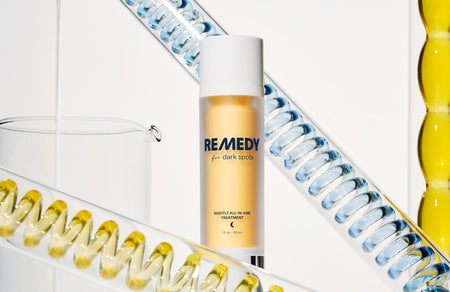How to Even Skin Tone on Legs, According to Dermatologists
Fade hyperpigmentation fast.


I’ve never been the girl with completely even, not-a-scratch-on-her skin. I scar at the slightest inconvenience, and my legs decided long ago that they love to hold onto hyperpigmentation and discoloration—especially in the summer. I've identified the cause of red spots on my skin (lots of bug bites) and tried the best dark spot correctors as part of my 20-something-year-long mission to figure out how to even skin tone on my legs.
Don't get me wrong: Some unevenness is entirely normal. Birthmarks aren’t going anywhere, and cuts or scrapes will inevitably leave their mark. But a handful of dermatologists recently cued me in on the best hyperpigmentation treatments capable of tackling sun spots, pimple pigmentation, and eczema flares. Remedies span easy at-home options (using a full-body retinol will make a world of difference) to more intensive treatments and lasers available only at the doctor’s office.
Here, board-certified dermatologists Mina Amin M.D., FAAD, Marisa Garshick M.D., FAAD, and Brendan Camp M.D., FAAD, along with Shiela Kassir, plastic surgeon and co-founder of Kassir Plastic Surgery, share their 10 top tips for evening out skin tone on your legs.
What Causes Uneven Skin Tone on the Legs?
The evenness of your skin tone is influenced by a handful of factors, many of which are out of an individual’s control. Genetics, race, and age all play a role and impact how much melanin, aka color, your skin grips onto. “Genetics play a significant role, as they determine your skin type, the amount of melanin produced, and how your skin reacts to various environmental factors. Race also affects skin tone evenness because different skin types have varying levels of melanin, which can influence susceptibility to discoloration,” explains Dr. Kassir, noting that those with darker skin tones are more likely to deal with pigmentation. “Age is another important factor; as you age, your skin can develop uneven pigmentation due to cumulative sun exposure, hormonal changes, and the natural aging process, which can all lead to a less even skin tone.”
That in mind, there are a handful of additional conditions or habits that have the potential to exacerbate uneven tone.

"Genetics, UV damage, and age contribute to the evenness of skin tone," says Dr. Amin.
Sun Damage
I always find that my discoloration and melasma is much worse in the summer—and its a fairly common shared experience. “Sun exposure stimulates pigment production as a way to protect skin cells from the damaging effects of UV rays,” explains Dr. Camp. “Photodamage can lead to the formation of sun spots and melasma, although the latter typically affects the face.”
Post-Inflammatory Hyperpigmentation
If you deal with body inflammation—adult-acne, bug bites, shaving marks—it’s safe to say you’ve dealt with post-inflammatory hyperpigmentation, the lingering redness or brown color that remains once the issue has been resolved. “Post-inflammatory hyperpigmentation (PIH) happens when the skin produces excess melanin (color) in response to an injury or inflammation, such as a cut, bug bite, or rash,” Dr. Kassir shares. “This condition is common among people with darker skin tones and can result in dark spots on the legs after the skin has healed.”
Stay In The Know
Get exclusive access to fashion and beauty trends, hot-off-the-press celebrity news, and more.
Vitiligo
“Vitiligo is a condition where the skin loses its pigment cells (melanocytes), leading to white patches on various parts of the body, including the legs,” explains Dr. Garshick. “The cause of vitiligo is not fully understood, but it is believed to be an autoimmune condition.” It presents as a depigmentation rather than dark spots but can contribute to an uneven skin tone. Some individuals are born with the condition, while others may develop small spots over time.

"I’ve heard when people think of vitiligo, they think of Micheal Jackson and me," model Winnie Harlow wrote via Instagram on World Vitiligo Day. "But Vitiligo is so much more complex than just two people. When I think of vitiligo, I think of how lonely it was growing up feeling like the only person in the world who was different like me. I’ve had the pleasure of meeting, getting messages from and getting tagged by so many of you over the years and just like you finally get to see yourself through me, I get to see myself through you. My younger self longed to have this community. To see myself in others."
Melanoma
While uneven tone is usually nothing to worry about, there are cases when spots should cause for concern about skin cancer. “An irregular mole or melanoma can present as a new irregular dark spot on the leg,” explains Dr. Amin. “If a mole is new or changing, see your dermatologist.” To know when something is cause for concern, I’ve always been told to look for the ABCDE warning signs on spots: Asymmetry, Border is irregular, Color, Diameter over six millimeters, Evolving or changing over time. If your spot has one or more of these factors, make an appointment with your doctor for a biopsy.
Eczema or Psoriasis
While eczema and psoriasis are different skin conditions, “both can result in itchy plaques on the skin, which can result in hyperpigmentation as the skin heals,” explains Dr. Amin. While they have distinct clinical features and treatments, both can alter skin tone by causing post-inflammatory hypopigmentation or hyperpigmentation, adds Dr. Camp. Your skin type and tone will influence the intensity of discoloration.
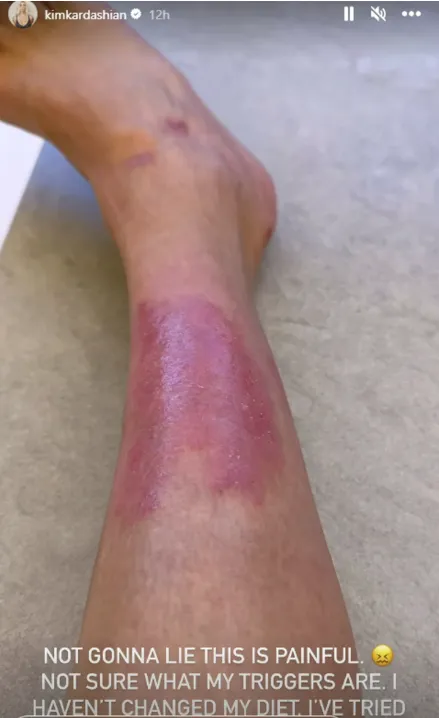
Kim Kardashian took to Instagram Stories last year to show a psoriasis flare on her legs.
Diabetes
If you’ve been diagnosed with diabetes, you should be under the care of a physician. In addition to managing the condition, however, your doctor should inform you of various skin conditions that can accompany the condition. One is called diabetic dermopathy. “It presents as light brown, scaly patches on the legs,” explains Dr. Kassir. “These patches are usually harmless but can contribute to an uneven skin tone. Poor blood circulation and high blood sugar levels in diabetics can also lead to other skin complications that affect pigmentation.”
How to Even Skin Tone on the Legs
The best way to treat uneven skin tone on the legs is largely determined by what’s causing your discoloration in the first place. Here, dermatologists share some easy tips you can incorporate into your routine or pursue at the doctor’s office. That said, if you suspect your discoloration is due to diabetes or possible melanoma, make sure to consult a board-certified physician as soon as possible.

There are plenty of easy, over-the-counter remedies and products to help even out skin tone on legs.
Wear Sunscreen
If your leg discoloration is from acne, bug bites, scratching, or picking, avoiding sun damage is going to be your best friend—especially in the summer. “It's crucial to protect your skin from sun damage by using a broad-spectrum sunscreen with at least SPF 30, wearing protective clothing, and avoiding peak sun hours,” explains Dr. Garshick. Unprotected exposure to the sun will not only contribute to additional sun spots, but it can also darken existing pigmentation. Make sure you use one of the best body sunscreens before heading out in the sun.
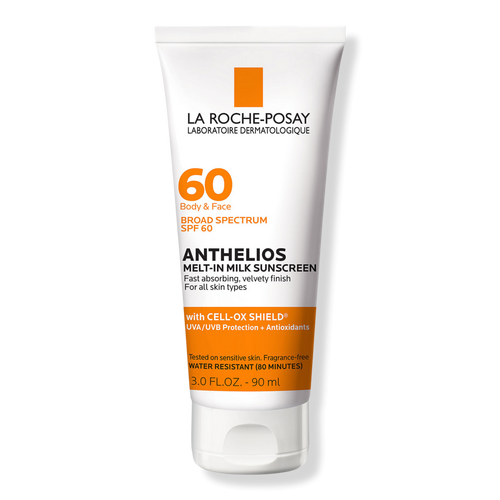
"Offering SPF 60 protection, this fast-absorbing chemical sunscreen can be used on the face and body and contains vitamin E, which has antioxidant properties," says Dr. Camp.
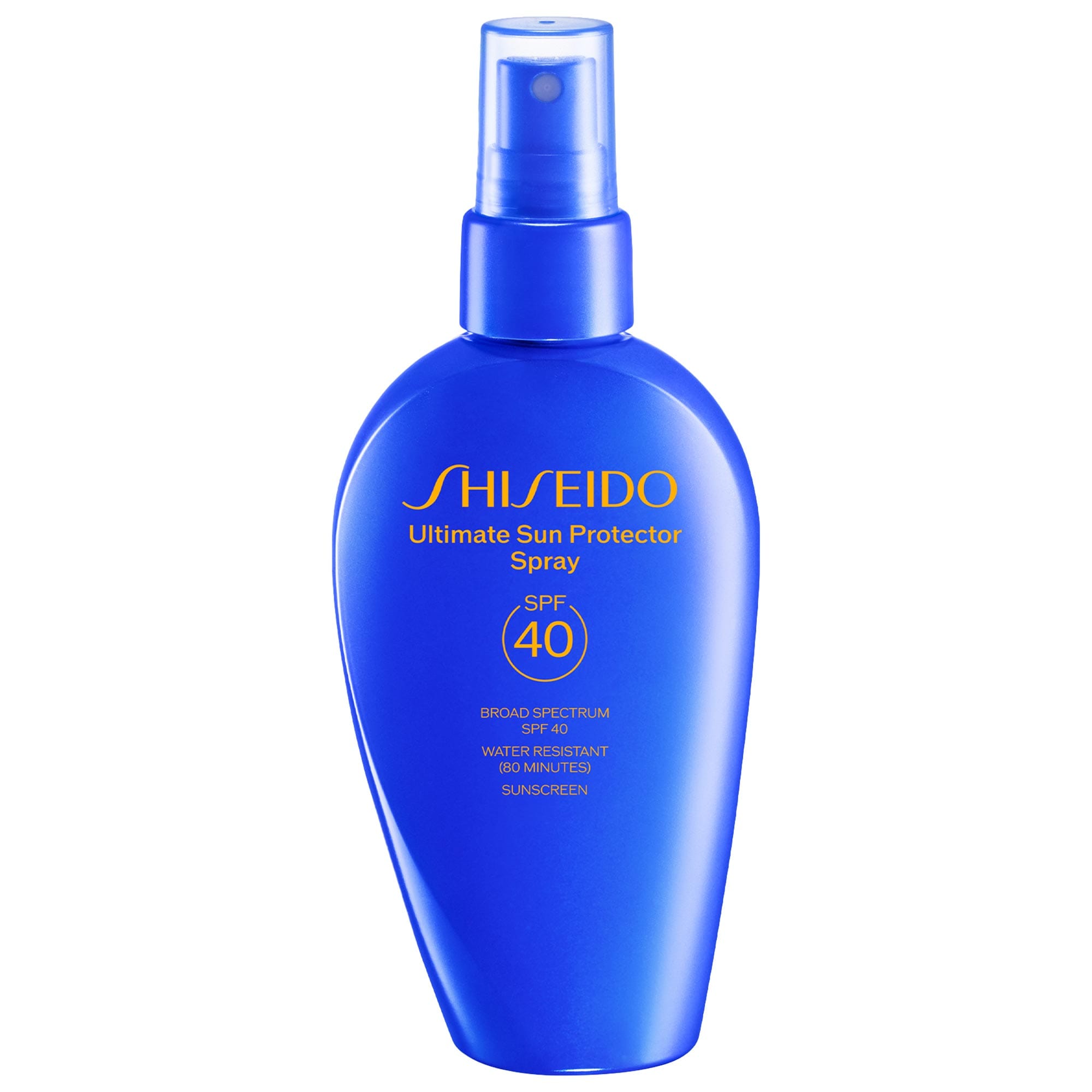
For an SPF that can tackle my face and my body, I reach for this elegant Shiseido formula. It's so lightweight, I forget I'm wearing it. Plus, with a formula that includes antioxidant-packed botanicals, it gives an extra dark spot-fading boost.
Don’t Pick
I’m a picker. I’m the first to admit that when I have a raised bump or knick, my hands are all up there—which is precisely what you’re not supposed to do. “Avoiding picking at scabs, bites, or other skin injuries can reduce the risk of post-inflammatory hyperpigmentation,” explains Dr. Kassir. Dr. Garshick also suggests treating cuts and scrapes promptly by applying Neosporin and a bandage until the wound has healed.
Try Exfoliating Ingredients
Whether your discoloration is caused by dry skin or lingering pigmentation, adding an exfoliating acid—such as salicylic, glycolic, or lactic—into your body skincare routine is worthwhile. “These ingredients break apart dead skin cells to facilitate their removal from the skin surface,” explains Dr. Camp. The sped-up cell turnover will, in turn, lighten dark spots and improve texture over time.

"For someone who prefers a physical exfoliant, this gentle body wash effectively cleanses the skin while gently eliminating dead skin cells, helping to improve overall skin tone and texture. Unlike harsh scrubs, it won’t leave the skin feeling dry or irritated," says Dr. Garshick.
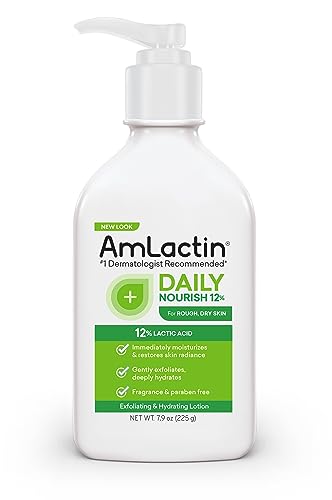
"This is a great option for those with uneven skin, especially on the legs as it gently exfoliates using lactic acid while simultaneously hydrating the skin so it won’t leave the skin feeling dry or irritated," says Dr. Garshick. "It helps to eliminate dead skin cells to leave the skin looking and feeling soft and smooth."
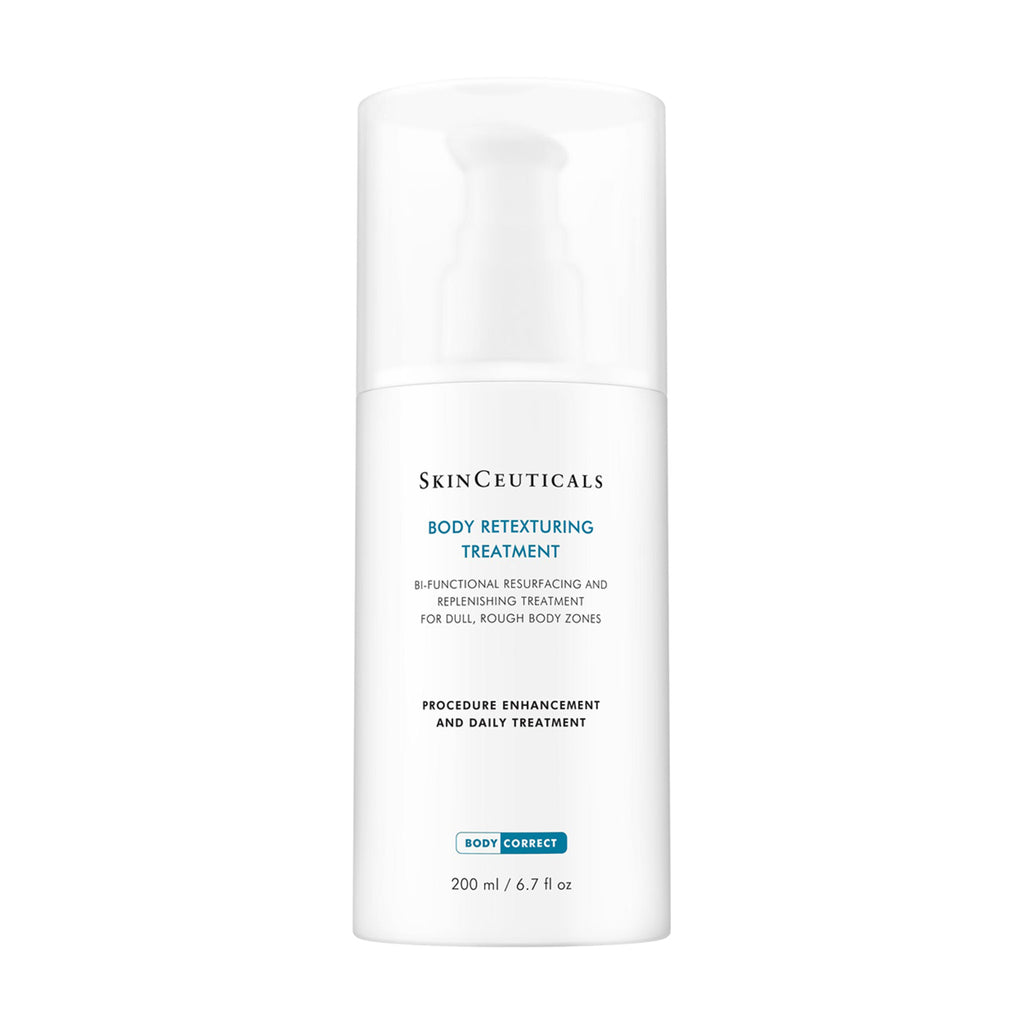
"This re-textures the damaged skin on your body. The gel formula blends hydroxyethyl urea/aminosulfonic acid compound with niacinamide and hyaluronic acid to provide thorough exfoliation coupled with replenishing hydration," explains Dr. Kassir. "It's especially beneficial to dry, rough skin on your elbows, knees, and heels."
Seek Out Antioxidants
There’s no shortage of body serums or the best body lotions out in the skincare world. If evening out the skin tone on your legs is your concern, seek out a product designed to brighten the skin. The best over-the-counter ingredients for the job are vitamin C, vitamin E, and niacinamide.
“Vitamin C is a potent antioxidant that brights the skin and reduces hyperpigmentation,” explains Dr. Kassir, noting that it also protects against free radicals that contribute to dark spots. “Niacinamide, a form of vitamin B3, helps to lighten dark spots and improve skin barrier function, too.”
Incorporate Retinol
I’m a huge retinol fan. I’ve been using a prescription cream on my face since I was 12 years old. But I never thought about putting a retinol serum or cream on my legs until Dr. Camp suggested it. “Retinols and retinoids can be used to normalize skin cell turnover, which can help even out skin blemishes,” he explains. It can be a bit drying, so it’s best to look for formulas that are boosted with other hydrating ingredients like ceramides, peptides, and hyaluronic acid. Only use a retinol product at night and make sure to apply sunscreen during the day, as it can make your skin more sensitive.
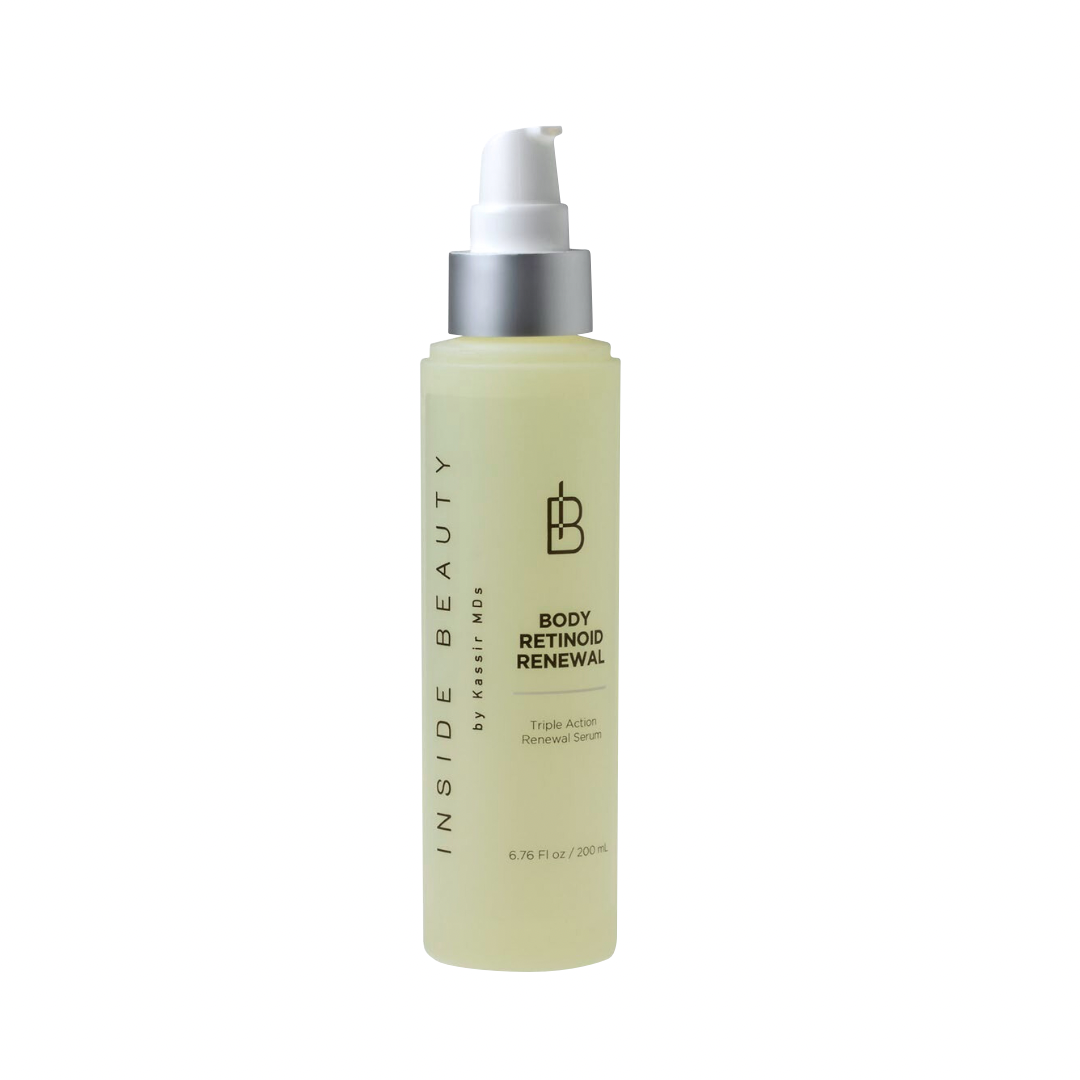
"This is a game changer for the legs. It evens skin tone and is a must for skin maintenance. The retinol is the youth boosting skincare for your body," explains Dr. Kassir. "The powerhouse ingredient of retinol (Vitamin A derivative) combined with ferulic acid , vitamins C and E, in a silky smooth serum, it helps to rebuild collagen and thicken the skin dermis for tight and firm smooth skin."
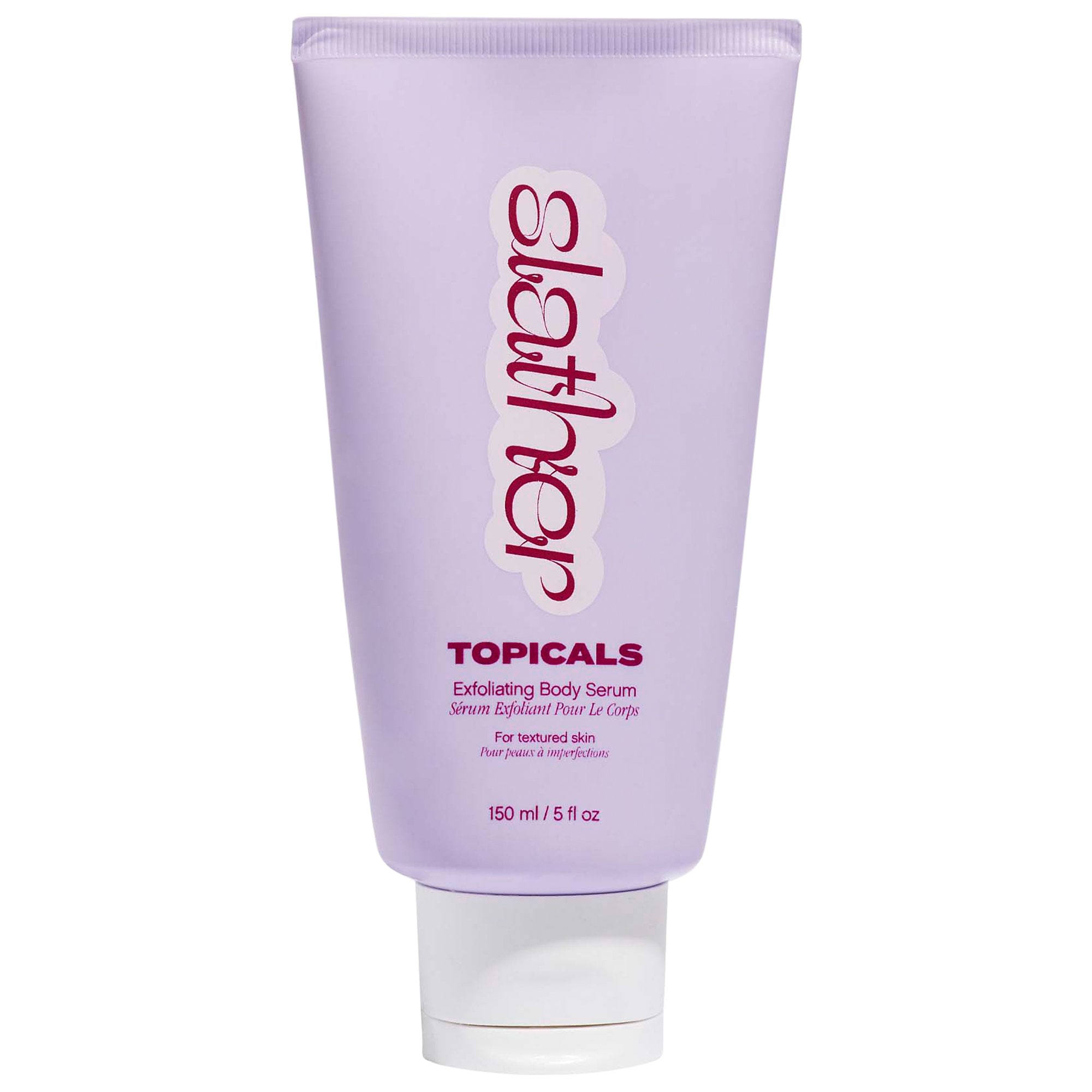
With a milky texture and a star lineup of ingredients including retinol, hydrating urea, and a blend of AHAs, this serum-meets moisturizer is loved by reviewers for its ability to target dullness, strawberry legs, and dark spots.
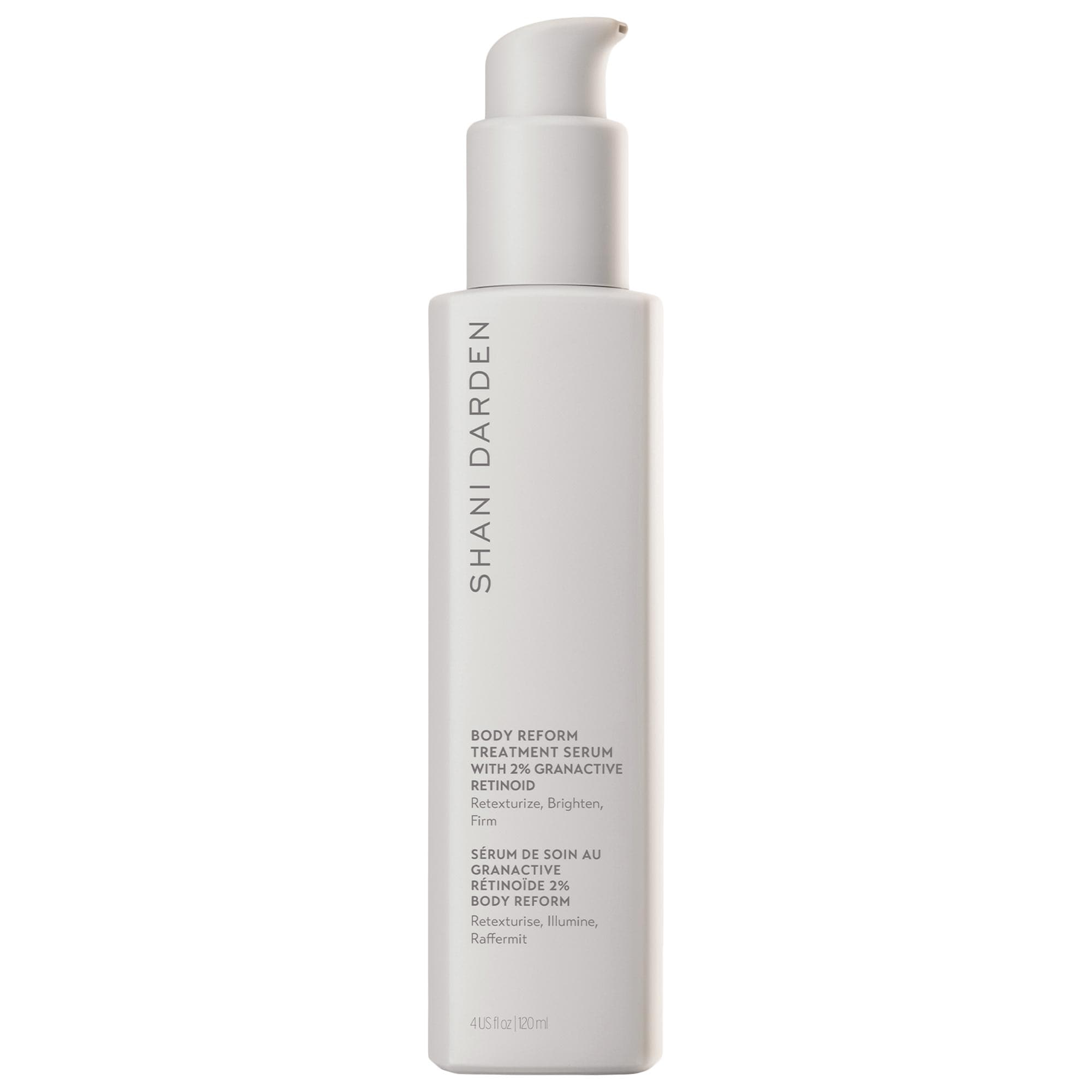
The product I single handedly recommend the most as a beauty editor is Shani Darden's Retinol Reform, which is a facial serum. This is the body counterpart—and rest assured it's just as good. With a powerful retinol and hydrating and soothing ingredients to boot, this will be effective without drying out your skin.
Stay Hydrated
Chances are, you’re already moisturizing post-shower. But if not, let this serve as your reminder. “Keeping your skin moisturized can help maintain its barrier function and prevent conditions like eczema,” explains Dr. Camp. In turn, your skin will be less prone to developing post-inflammatory hyperpigmentation. Check out the best creams for eczema if you need some inspiration.
Opt for a Perscription Cream
If the discoloration on your legs doesn’t want to budge despite continued use of over-the-counter products, your dermatologist might suggest a prescription cream with hydroquinone, a powerful lightening agent that reduces melanin production. “This can help with dark spots on the skin. However, they should be used for three months, then stopped,” explains Dr. Amin. “The cycle is repeated as necessary.” Hydroquinone, when used improperly and long-term, has been shown to affect the liver and kidneys negatively. With that in mind, ensure you’re under a physician’s care and have regular check-ins.
If inflammation, eczema, or psoriasis is the source of your pigmentation, your doctor might prescribe a corticosteroid, essentially a more powerful version of hydrocortisone. “These can reduce inflammation and improve the appearance of dark spots caused by inflammatory conditions,” says Dr. Kassir.
Get a Laser
In-office lasers will cost you a bit of money (you’re looking at a couple thousand when all is said and done), but they can be very efficient at lightening dark spots on the legs. “Laser treatments, such as fractional laser and intense pulsed light (IPL) therapy, target pigmented areas and break down excess melanin,” explains Dr. Kassir. “Fractional lasers create micro-injuries that stimulate collagen production and skin regeneration, leading to a more even tone. IPL uses broad-spectrum light to target pigment and vascular lesions, improving discoloration.”
Lasers are an investment, so make sure you’re talking to your dermatologist or plastic surgeon about every option.
@thevieco ♬ Dance You Outta My Head - Cat Janice
Consider a Chemical Peel
When you think of a chemical peel, you probably envision a facial treatment. But the same fomulas (yes, even at-home chemical peels) can be used on your legs. In fact, you might even be able to tolerate a more intense acid. “Chemical peels involve applying a solution to the skin that causes it to exfoliate and eventually peel off,” explains Dr. Garshick. “This process removes the top layer of damaged skin, revealing fresher, more evenly toned skin underneath.”
Manage Conditions
A large component of treating uneven tone on the legs centers on prevention. If you have vitiligo, diabetes, eczema, or psoriasis, you’ll benefit from swift intervention and professional care. “Managing underlying health conditions like diabetes and seeking prompt treatment for skin conditions like eczema or psoriasis can help maintain an even skin tone,” emphasizes Dr. Kassir. Your doctor will be able to devise a specific treatment plan that will not only treat your condition but also help minimize flares that can lead to dark spots on the legs.
When to See a Doctor About Uneven Tone on Legs
“It is time to see a doctor if OTC treatments are ineffective, if the discoloration worsens, or if there are signs of skin cancer, such as new or changing moles,” explains Dr. Kassir. “Consulting with a medical professional can provide a personalized treatment plan and ensure that any underlying conditions are properly managed.”
You also might consider seeing a doctor if you want birthmarks removed or are considering repigmentation procedures for vitiligo.
Meet the Experts

Dr. Sheila Malek Kassir is a board certified plastic surgeon from Germany and an internationally recognized beauty expert on novel and trusted cosmetic procedures including the latest beauty trends and innovations from Europe. She first saw the gap between scientific advances in beauty and common beauty trends during her career as a German film and TV actress. With her personal experience in the industry she was uniquely positioned to provide novel cosmetic advances to her fellow co-stars and thespians. Dr. Malek Kassir then decided this information and the services of the latest beauty techniques should be more accessible and travelled the world searching for differences in beauty techniques and standards and latest plastic surgery techniques to bring to everyone. Other spots of her Plastic Surgery training around the world were Plastic and Reconstructive Surgery at Yale New Haven, Komfo Anokye teaching hospital in Kumasi Ghana, Queen Elisabeth Hospital in Bridgetown Barbados, multiple hospitals in Germany, Switzerland and Iran, and eventually she went back to the USA where she was trained by Dr. Ramtin Kassir. Her special interests are plastic and cosmetic surgery of the face and body.

Marisa Garshick, M.D., FAAD is a leading board-certified dermatologist serving patients throughout Manhattan, New York and Englewood, NJ at MDCS Dermatology: Medical Dermatology & Cosmetic Surgery, as well as an assistant clinical professor of dermatology at Cornell - New York Presbyterian Medical Center. Dr. Garshick provides a wide variety of cosmetic and medical procedures and services including treatments for acne, eczema, hyperhidrosis, moles, psoriasis, rosacea, signs of aging, skin cancer, skin tags, vitiligo, and wrinkles.
She completed her undergraduate education at Emory University and attended medical school at Tufts University School of Medicine, where she graduated with Research Honors and Alpha Omega Alpha. As a medical student, Dr. Garshick was awarded the prestigious Doris Duke Clinical Research Fellowship at Harvard Medical School, during which she performed dermatology clinical trials and research at Massachusetts General Hospital. She was also awarded the American Medical Women’s Association Glasgow-Rubin Academic Achievement Award for graduating in the top of her class and the William Dameshek Award for Research Excellence. Dr. Garshick’s post-graduate training in dermatology began with an internship at Memorial Sloan Kettering Cancer Center. She completed her dermatology residency at Cornell’s New York Presbyterian Hospital, where she served as Chief Resident in Dermatology. Dr. Garshick has numerous publications in scientific journals and book chapters, including a chapter on the treatment of acne, and has presented at national meetings. She specializes in general medical dermatology, including adults and pediatrics, and cosmetic dermatology, including neurotoxins, fillers, chemical peels, and lasers.

Brendan Camp, M.D., is double board-certified in dermatology and dermatopathology and sees patients at MDCS Dermatology: Medical Dermatology & Cosmetic Surgery, which has locations in Upper East Side, Hampton Bays, Commack, Smithtown, Plainview, and Midtown East of Manhattan, New York. Patients have been coming to him for his expertise managing medical conditions like acne, rosacea, eczema, warts, psoriasis, moles, and skin cancer, as well as cosmetic concerns and treatments with Botox, fillers, lasers, and other skin rejuvenation devices.
Dr. Camp graduated with honors from Cornell University, earning a degree in biochemistry. As a medical student at SUNY Upstate Medical University in Syracuse, he participated in a one-year epidemiology fellowship at the Centers for Disease Control and Prevention (CDC) in Atlanta, Georgia, where he participated in viral outbreak investigations.
He has previously served as an assistant professor of dermatology at George Washington University School of Medicine and Health Sciences and worked in private practice just outside Washington DC in Northern Virginia.
Dr. Camp is the author of several scientific articles that have been published in the Journal of the American Academy of Dermatology, the Journal of Cutaneous Pathology, and the Journal of Clinical Oncology. He has also presented at meetings of the American Academy of Dermatology, the American Society of Dermatopathology, and the Society for Investigative Dermatology. Additionally, he is a reviewer for the Journal of the American Academy of Dermatology Case Reports, a member of the Curriculum Task Force and previous member of the Public Education Committee of the American Academy of Dermatology.

Dr. Mina Amin is a dermatologist in Los Angeles, California and is affiliated with Kaiser Permanente Los Angeles Medical Center. She received her medical degree from University of California and has been in practice between 6-10 years.

Samantha Holender is the Senior Beauty Editor at Marie Claire, where she reports on the best new launches, dives into the science behind skincare, and shares the breakdown on the latest and greatest trends in the beauty space. She's studied up on every ingredient you'll find on INCI list and is constantly in search of the world's glowiest makeup products. She's constantly tracking the biggest nail and hair trends to pop up in the beauty space, going backstage during fashion weeks, tracking celebrity looks, and constantly talking to celebrity hair stylists, nail artists, and makeup artists. Prior to joining the team, she worked as Us Weekly’s Beauty and Style Editor, where she stayed on the pulse of pop culture and broke down celebrity beauty routines, hair transformations, and red carpet looks. Her words have also appeared on Popsugar, Makeup.com, Skincare.com, Delish.com, and Philadelphia Wedding. Samantha also serves as a board member for the American Society of Magazine Editors (ASME). She first joined the organization in 2018, when she worked as an editorial intern at Food Network Magazine and Pioneer Woman Magazine. Samantha has a degree in Journalism and Mass Communications from The George Washington University’s School of Media and Public Affairs. While at GWU, she was a founding member of the school’s HerCampus chapter and served as its President for four years. When she’s not deep in the beauty closet or swatching eyeshadows, you can find her obsessing over Real Housewives and all things Bravo. Keep up with her on Instagram @samholender.
-
 Blake Lively Just Found the Kitschiest Chanel Bag of All Time
Blake Lively Just Found the Kitschiest Chanel Bag of All TimeShe's back in method dressing business.
By Kelsey Stiegman
-
 Underrated New Balance Sneakers Are Priyanka Chopra's Athleisure Hero
Underrated New Balance Sneakers Are Priyanka Chopra's Athleisure HeroThey're the star of her latest look.
By Kelsey Stiegman
-
 Travis Kelce's Mom Reportedly "Liked" a Comment About His Future as a Dad
Travis Kelce's Mom Reportedly "Liked" a Comment About His Future as a Dad...and then removed it.
By Lia Beck
-
 Everything You Need to Know About Marie Claire’s Skin and Hair Awards
Everything You Need to Know About Marie Claire’s Skin and Hair AwardsCould your brand survive an editor testing session?
By Ariel Baker
-
 The 11 Best Spring Makeup Trends Are Sexy, Sensual, and Perfectly Luminous
The 11 Best Spring Makeup Trends Are Sexy, Sensual, and Perfectly LuminousIt's dew or die time.
By Jamie Wilson
-
 Simone Ashley’s Indie Sleaze Glam Is a Cool-Toned Dream
Simone Ashley’s Indie Sleaze Glam Is a Cool-Toned DreamThe actor was spotted in New York City looking like the epitome of cool-toned beauty.
By Ariel Baker
-
 The 10 Best Hair Growth Shampoos of 2025, Tested by Editors
The 10 Best Hair Growth Shampoos of 2025, Tested by EditorsExpensive and healthy-looking hair on lock.
By Marisa Petrarca
-
 New York Fashion Week’s Fall/Winter 2025 Best Beauty Moments Are a Lesson in Juxtaposition
New York Fashion Week’s Fall/Winter 2025 Best Beauty Moments Are a Lesson in JuxtapositionThe week's best beauty looks were a maximalism master class.
By Ariel Baker
-
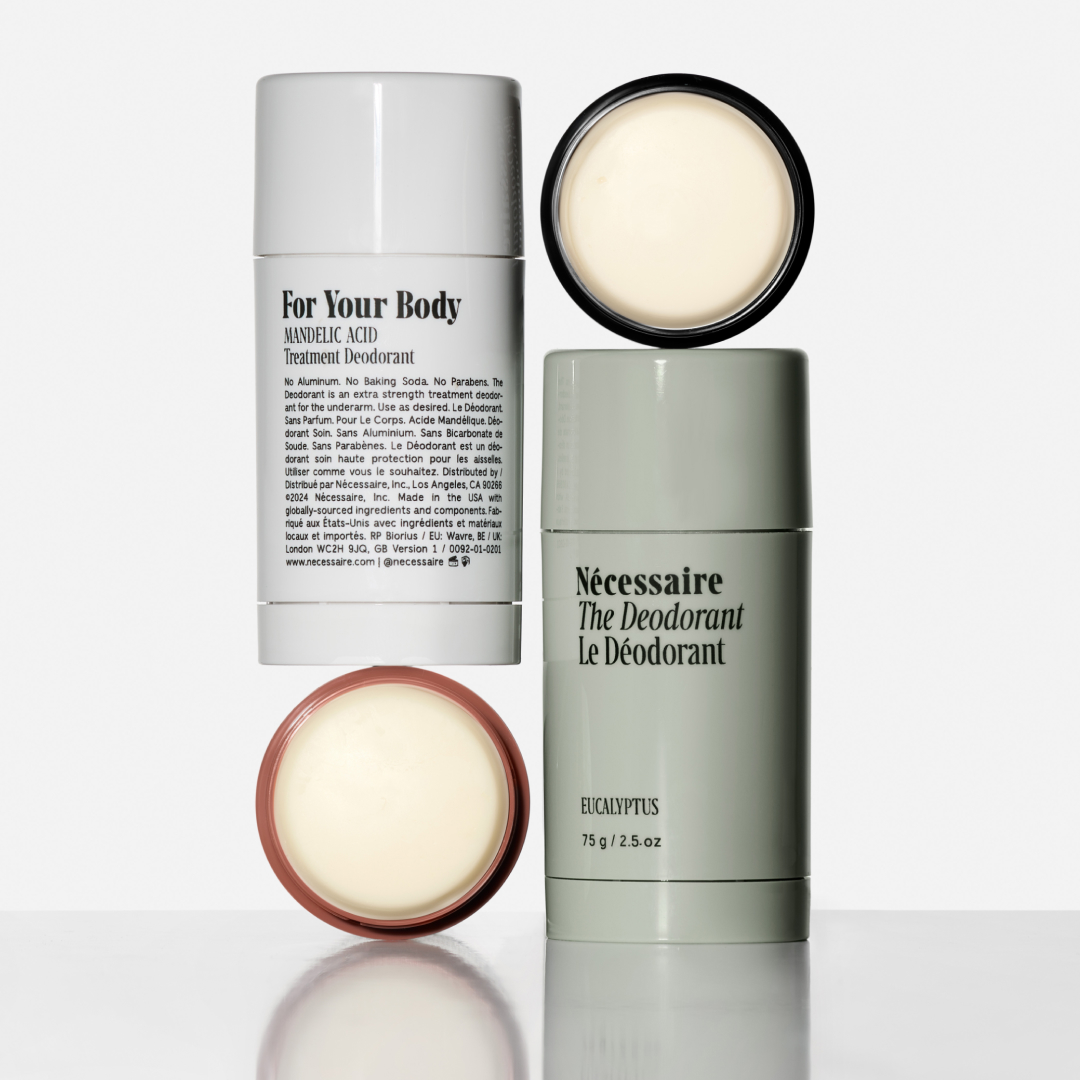 Nécessaire's Extra-Strength Deodorant Outlasts an Editor's Sweatiest Test: Fashion Week
Nécessaire's Extra-Strength Deodorant Outlasts an Editor's Sweatiest Test: Fashion WeekEven with my hectic schedule, I've never smelled better.
By Halie LeSavage
-
 Lily-Rose Depp’s Cool-Toned Makeup Is So ‘90s Coded
Lily-Rose Depp’s Cool-Toned Makeup Is So ‘90s CodedClean girl meets grunge.
By Ariel Baker
-
 The 15 Best Foundations for Mature Skin, Tested by Women Over 50
The 15 Best Foundations for Mature Skin, Tested by Women Over 50It's perfect for mature complexions.
By Siena Gagliano



